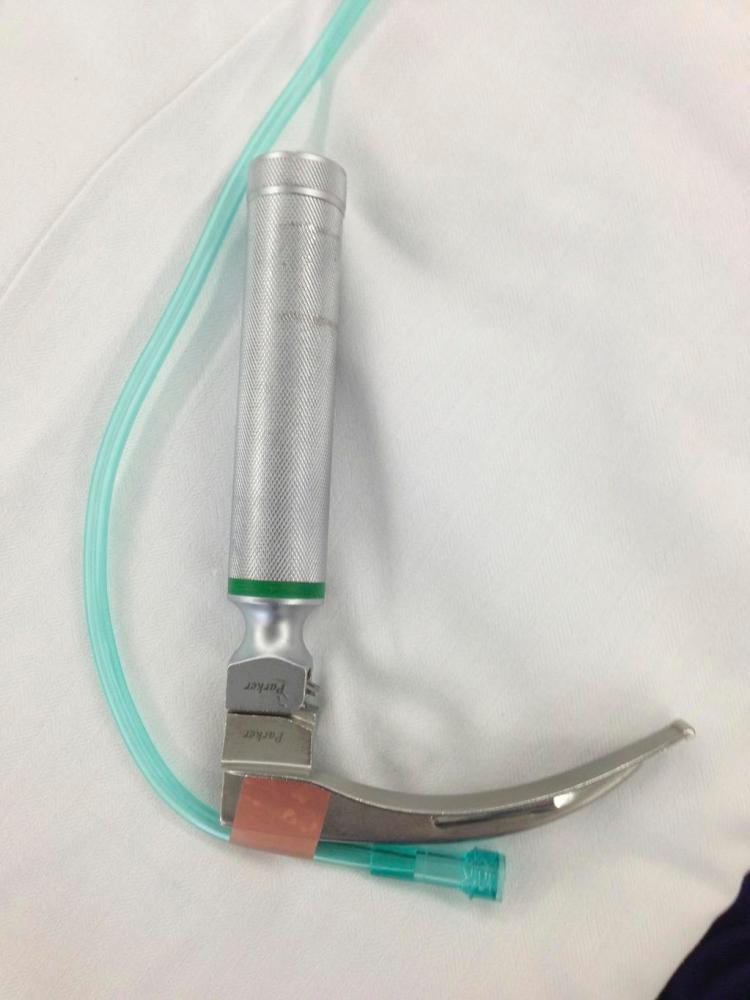
Have you ever wondered if NODESAT could be improved?
It Can!
Published in Journal of Emergency Medicine this month, this article!
A Dual-Use Laryngoscope to Facilitate Apneic Oxygenation
The cover picture is of an improvised laryngoscope with oxygen tubing that my mate Dr Nicholas Chrimes tweeted a year ago. It remarkably looks very similar to the device described in this article now!
So having nasal cannulae at 15 L/min as well as a laryngoscope with oxygen source at 6-8L/min flow, may well be the ultimate apnoeic oxygenation setup for intubation!

What is old is new again. I remember seeing a pediatric blade with a O2 port years ago. I was never able to find one for adults though.
Similar pictures to Nicks published in 2012 by these guys, in that well known journal the SJA
http://www.saudija.org/article.asp?issn=1658-354X;year=2012;volume=6;issue=4;spage=433;epage=434;aulast=Barad
I think the FOAMed version would have got more coverage!
I guess the Bullard laryngoscope had the potential for this with it’s O2/suction port. However the addition of O2 for ApOx via a Mac type blade would seem intuitive and an inevitable evolution.
Now all we need is a simple, low cost device that will allow both DL and VL, O2 insufflation and preferably allow the operator to continue to allow o2 insufflation even if have to use both hands for another task eg ESA. Any reason not to bung a CMOS chip on blade as well?
Perhaps integrate it with McKesson dental props so can look-insufflate-stabilise device and operate hands free. With wi fi streaming of DL/VL view to slaved anaes monitor?
So many possibilities…
Good stuff.
When facing critically hypoxemic patients, this is a great idea during airway management.
On the Miller blade, the tubing could be secured on the outer portion of the blade, so as not to encroach on the narrow line of sight of the interior of the blade. The big obstacle with using tubing on these blades is not to encroach on the line of sight. You’d need to prep a blade well in advance, unless you practiced how to assemble it in simulation.
Another take on this idea is to actually O2 enable the Yankauer suction. Let me explain.
–Use suction as needed, and use it to position the DL or VL blade, i.e, as a tongue depressor.
–Connect the suction tubing to O2 outlet to begin insufflation during the intubation procedure. Should hypoxia begin to develop, the Yankauer can be positioned near or within the larynx itself (theoretical use of the Yankauer, please use the Yankauer within the limits of your understanding of airway management).
So I’m saying that you can deliver O2 through a Yankauer. And you can rescue ventilate with it as well.
In the past when I have provided sedation for awake craniotomy, I began to consider solutions for rescue ventilation for instances in which I over sedated the patient. Consider the situation–patient is secured to the OR table by a head frame (screws through frame into skull, frame secured to table), head and neck often flexed to a certain degree. Different phases of the surgical procedure require moderate sedation alternating with minimal sedation. When changing from minimal to moderate sedation, the potential for deep sedation can occur.
Mask ventilation pretty darn hard if required. Two strategies were obvious–one involved a jaw thrust and yelling at the patient to breathe, the other might involve SGA insertion and bagging the patient. The third strategy? Here you go:
—>Connect a Yankauer to O2 gas source, 5-10 lpm. Introduce Yankauer around the base of tongue to relieve the airway obstruction (if present), and allow the patient to ventilate (with O2 delivered at base of tongue). Should apnea not resolve with this maneuver, pinch shut the patient’s nose and mouth around the Yankauer, and therefore deliver a positive pressure breath into the patient. Release nose and mouth-pucker maneuver to allow exhalation. Does this work? Uh, yeah, it worked for me in one of these cases until the apnea resolved.
Bear in mind that positive pressure Yankauer ventilation is possible (if tip not pushed into esophagus), but again, please use the Yankauer within the limits of your understanding of airway management.
I’ll attempt to demonstrate with a Simulation video in the next week.
I had a good laugh when I saw the cover picture. When I did my initial ALS paramedic training in 2004 (in South Africa) we learned to intubate sedated but spontaneously breathing patients. As these intubations can take some time we were taught to place the oxygen tubing in the patients oropharynx during laryngoscopy, maintaining the sats until intubation was achieved.
Ha! Thanks!
The Truphatek Video Laryngoscope (http://www.truphatek.com/video.php?ID=1 or you can search for one on EBAY – seriously) has a “jet oxygen” system that can be used for delivering oxygen to the oropharynx during intubation attempts. But it costs about 8000 American dollars
Good info and food for thought. Years ago I saw Medics using a Laryngoscope with a Yankauer taped to it for intubation. But thinking this throught now probably suctioned patients into a desat situation. The above would work in reverse is my guess?